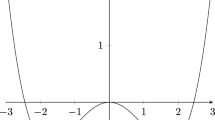Abstract
We consider stochastic differential equations in d-dimensional Euclidean space driven by an m-dimensional Wiener process, determined by the drift vector field f0 and the diffusion vector fields f1,...,fm, and investigate the existence of global random attractors for the associated flows φ. For this purpose φ is decomposed into a stationary diffeomorphism Φ given by the stochastic differential equation on the space of smooth flows on Rd driven by m independent stationary Ornstein Uhlenbeck processes z1,...,zm and the vector fields f1,...,fm, and a flow χ generated by the nonautonomous ordinary differential equation given by the vector field (∂Φt/∂x)−1[f0(Φt)+∑ 1i=1 fi(Φt)z it ]. In this setting, attractors of χ are canonically related with attractors of φ. For χ, the problem of existence of attractors is then considered as a perturbation problem. Conditions on the vector fields are derived under which a Lyapunov function for the deterministic differential equation determined by the vector field f0 is still a Lyapunov function for χ, yielding an attractor this way. The criterion is finally tested in various prominent examples.
Similar content being viewed by others
REFERENCES
Arnold, L. (1998). Random Dynamical Systems, Springer, Berlin.
Arnold, L., and Scheutzow, M. (1995). Perfect cocycles through stochastic differential equations. Probab. Th. Rel. Fields 101, 65-88.
Bismut, J. M., and Michel, D. (1981). Diffusions conditionnelles. I. J. Funct. Anal. 445, 174-211.
Bismut, J. M., and Michel, D. (1982). Diffusions conditionnelles. II. J. Funct. Anal. 45, 274-292.
Crauel, H. (1993). Markov measures for random dynamical systems. Stochast. Stochast. Rep. 37, 13-28.
Crauel, H., Debussche, A., and Flandoli, F. (1997). Random attractors. J. Dynam. Diff. Eqs. 9(2), 307-341.
Crauel, H., and Flandoli, F. (1994). Attractors for random dynamical systems. Probab. Th. Rel. Fields 100, 365-393.
Flandoli, F., and Schmalfuss, B. (1996). Random attractors for the 3D Navier Stokes equation with multiplicative white noise. Stochast. Stochast. Rep. 59, 21-45.
Kunita, H. (1990). Stochastic Flows and Stochastic Differential Equations, Cambridge University Press, Cambridge.
Keller, H., and Ochs, G. (1998). Numerical Approximation of Random Attractors, Report No. 431, Universität Bremen.
Keller, H., and Schmalfuss, B. (1998). Attractors for stochastic differential equations with non-trivial noise. Izvest. Akad. Nauk RM 26, 43-54.
Ledrappier, F. (1986). Positivity of the exponent for stationary sequences. In Arnold, L., and Wihstutz, V. (eds.), Lyapunov Exponents, LNM 1186, Springer, Berlin.
Le Jan, Y. (1986). Equilibre statistique pour les produits de difféomorphismes aléatories indépendants. CRAS 302, 351-354.
Leonov, G. A., and Boichenko, V. A. (1992). Lyapunov's direct method in the estimation of the Hausdorff dimension of attractors. Acta Appl. Math. 26, 1-60.
Lyons, T. (1998). Differential equations driven by rough signals. Preprint, Imperial College, London.
Ocone, D., and Pardoux, E. (1989). A generalized Itô-Ventzell formula. Application to a class of anticipating stochastic differential equations. Ann. Inst. H. Poincaré 25, 39-71.
Schenk-Hoppé, K. R. (1996). Bifurcation scenarios of the noisy Duffing-van der Pol oscillator. Nonlin. Dynam. 11, 255-274.
Schenk-Hoppé, K. R. (1998). Random attractors: General properties, existence and applications to stochastic bifurcation theory. Discrete Cont. Dynam. Syst. 4, 99-130.
Schmalfuss, R. (1997). The random attractor of the stochastic Lorenz system. ZAMP 48, 951-974.
Schmalfuss, B. (1998). A measurable fixed point theorem and the measurable graph trans-formation. JMAA 225, 91-113.
Spivak, M. (1979). A Comprehensive Introduction to Differential Geometry , Vol. 1, 2nd ed., Pub. Berkeley.
Sznitman, A. S. (1982). Martingales dépendant d'un paramétre: Une formule d'Itô. Z. Wahr-scheinlichkeitstheorie verw. Geb. 60, 41-70.
Ventzell, A. D. (1965). On the equation of the theory of conditional Markov processes. Theory Probab. Appl. 10, 357-361.
Author information
Authors and Affiliations
Rights and permissions
About this article
Cite this article
Imkeller, P., Schmalfuss, B. The Conjugacy of Stochastic and Random Differential Equations and the Existence of Global Attractors. Journal of Dynamics and Differential Equations 13, 215–249 (2001). https://doi.org/10.1023/A:1016673307045
Issue Date:
DOI: https://doi.org/10.1023/A:1016673307045



